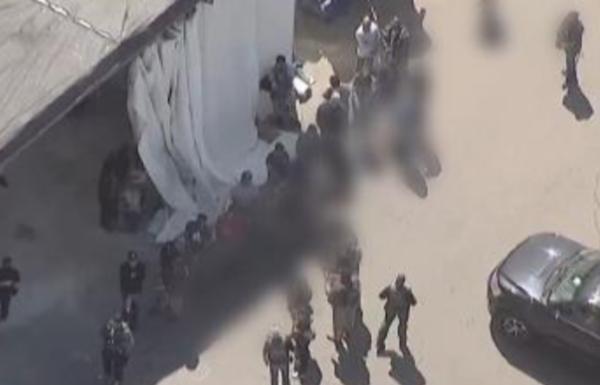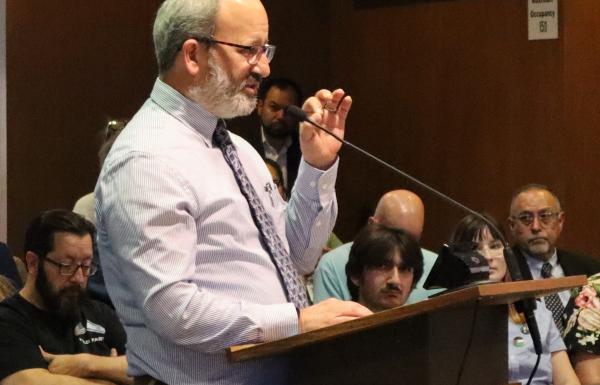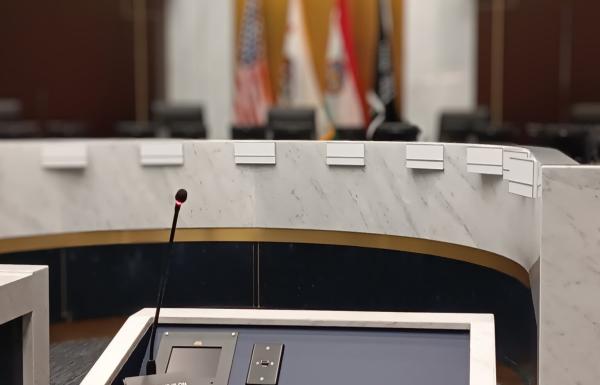By Miriam Raftery
January 8, 2025 (La Mesa) – Dozens of public speakers at yesterday’s Grossmont Healthcare District meeting urged the board to move its 9 a.m. meetings to evenings in order to accommodate people with full-time jobs. The proposal was made by newly elected director Nadia Farjood, a working mother who says her new full-time job at the District Attorney’s office prevents her from attending daytime meetings.
The district represents about 520,000 residents. Around 271 people signed a petition in support of Farjood’s proposal, and around 40 showed up in support at yesterday’s meeting. But despite testimony from union representatives, healthcare workers, district residents and local elected officials, Farjood’s proposal failed, with no other director in support.
Some speakers voiced concern not only for Farjood, but for the potential chilling effect on would-be candidates who may be persuaded from running for office if they have full-time day jobs.
By Miriam Raftery
Photo, left: Jamul tribal chairwoman Erica Pinto
January 8, 2025 (Jamul) – On December 23, President Joe Biden signed into law the bipartisan Jamul Indian Village Land Transfer Act, which places 172 acres of land in East County, San Diego into tribal trust for the Jamul Indian Village.
“Thank you to Senators Padilla and Butler, and Representatives Issa and Vargas for their leadership,” Biden said upon signing S. 3857 authored by California Senator Alex Padilla into law. The companion measure in the House was authored by Congressman Darrell Issa.
By Jessica Brodkin Webb
January 7, 2025 (El Cajon) --In 13 days, President-elect Donald Trump could potentially begin to make good on his campaign promise to pursue mass deportations of immigrants and refugees living in the United States.
“As President I will immediately end the migrant invasion of America," Trump said in a Sept, 2024 speech and although he has not released specific details of how he might direct such a plan at a federal level, community leaders stand divided on how best to respond at the local level.
Under current California law, state and municipal governments are barred from working in conjunction with federal law enforcement agencies to actively pursue deportation for anyone who has not committed a serious crime. That approach stands in direct opposition to Trump’s proposed plan to conduct mass immigrant deportations.
El Cajon Mayor Bill Wells, in a letter to the Calif. Attorney General, says he plans to propose that his city fully cooperate with federal immigration authorities. San Diego’s Board of Supervisors majority, by contrast, has urged county authorities not to turn over any immigrants to federal authorities, while the County Sheriff has said she will take the middle ground and follow state law, cooperating only when immigrants have committed serious crimes.
Besides posing a challenge for local elected officials who must decide how they will answer to conflicting state and federal guidelines, an element of murkiness also exists for prominent community members and social service agency heads who spend many hours each week working directly with refugees.
January 8, 2025 (San Diego's East County) -- The National Weather Service has issued a red flag warning for San Diego County mountains and valleys today and tomorrow due to high winds and extreme fire danger. The strong winds that have fueled two large wildfires decimating Los Angeles County are forecast to move into San Diego County next.
This is the driest winter period measured from October 1 through January 8 since 1850, according to the National Weather Service, increasing fire danger.
Due to high winds and potential power outages, schools in six local districts will be closed today. The San Diego County Office of Education announced the closures for:
- Julian Union Elementary School District
- Julian Union High School District
- Mountain Empire Unified School District
- Ramona Unified School District
- Spencer Valley School District
- Warner Unified School District
“The safety of students and school staff is of the utmost importance to San Diego County school districts,” officials said in a news release.
In Los Angeles County, devastating fires have collectively destroyed over 1,000 homes and two people have died, the Los Angeles Times reports.
By Miriam Raftery
Photo by Henri Migala
January 7, 2025 (Los Angeles) – The fast-moving Palisades Fire has burned 2,921 acres as of tonight, according to Cal Fire. The wildfire that began around 10:30 a.m. in Pacific Palisades has now forced evacuation of approximately 10,000 residents from 30,000 homes in Malibu, Topanga and Pacific Palisades, also forcing closure of portions of Pacific Coast Highway.
The fire is expected to worsen overnight, with extremely dangerous winds up to 100 miles per hour possible, the National Weather Service predicts. Already, gusts up to 70 miles per hour have fueled the conflagration. Wind speeds are expected to peak tomorrow, though strong winds are forecast through Friday.
Both Governor Gavin Newsom and the City of Los Angeles have issued emergency declarations. “This is a highly dangerous windstorm that’s creating extreme fire risk—and we’re not out of the woods,” Newsom said.
East County News Service
January 6, 2025 (La Mesa) – Tomorrow at 9 a.m., the Grossmont Healthcare District board of directors will consider a proposal by newly elected board member Nadia Farjood to change the board’s meeting times to evenings or weekends. But a survey of board members shows no support for that plan. The board previously experimented with holding evening meetings but found that attendance by the public dropped, multiple members noted.
Farjood, an attorney, has said that her day job prevents her from attending any meetings Monday through Friday between 7:30 a.m. and 6 p.m., when she has court appearances, as well as from 6 to 9 p.m. on the second and third Tuesdays each month.
East County News Service
January 6, 2025 (Santee) – Jordan Marks, San Diego County Assessor-Recorder-County Clerk (ARCC), has announced that early appointments are now available for civil wedding ceremonies between 8 a.m. and 5 p.m. on Valentine’s Day, Friday, Feb. 14, 2025. Couples can book their Valentine’s Day appointments for marriage licenses and ceremonies at one of four ARCC offices, including Santee, Chula Vista, San Marcos and the San Diego Downtown ARCC headquarters at the County Administration Center, 1600 Pacific Highway, San Diego. The Downtown location also offers indoor ceremony rooms or a picturesque, outdoor marriage arbor on the waterfront. The ARCC Santee branch office in East County is located at 10144 Mission Gorge Ave.
Source: SDG&E
January 6, 2025 (San Diego) – Due to extreme fire weather conditions and forecasted Santa Ana winds, San Diego Gas & Electric Company (SDG&E) has notified 64,866 customers that it may have to turn off power to reduce wildfire risk as early as Tuesday. Public Safety Power Shutoffs (PSPS) are approved by state regulators as an important safety tool of last resort to mitigate fire risk during dangerous weather conditions.
This week marks the driest start to the rainy season in San Diego County in 174 years. As a result of these dry conditions and expected Santa Ana winds, the National Weather Service has issued a Red Flag Warning for parts of Orange and San Diego Counties beginning Tuesday evening through late Wednesday night. SDG&E’s meteorology team is closely monitoring weather conditions.
Power shutoffs are possible in the following areas:
By Miriam Raftery
January 2, 2025 (San Diego’s East County) – 2024 has been a turbulent year, from devastating floods in January to controversies over homelessness and immigration, contentious elections, land use and fire issues, expansion of Jamul tribal lands, officials grappling with hate speech, resignation of the County Supervisors' Chairwoman Nora Vargas, and at year’s end, Syrian-Americans rallying in El Cajon to celebrate the fall of the Assad regime.
Below are the top stories of the year which had an impact in East County communities.
By Miriam Raftery
Photo, left: surveillance footage from New Orleans terror attack
January 3, 2025 (San Diego) – A U.S. military veteran drove a rented electric pickup truck into a crowd of New Year’s Day revelers in New Orleans shortly after 3 a.m. on New Year’s morning, killing 14 people before he was fatally shot by police officers. Authorities found improvised explosive devices (IEDs) planted in the area; ABC news reports that an explosion to a hotel has been tied to the driver, The FBI reports that he posted videos declaring support for the terror group ISIS shortly before the attack, which the FBI confirms was an act of terrorism.
Later in the day, a U.S. Army Green Beret on leave detonated a rented Tesla filled with explosives and fireworks in front of Trump Tower in Las Vegas; his motive is not yet clear. The medical examiner confirmed that the driver shot himself before his body was burned in the explosion. Both attackers were U.S. citizens.
Tonight, the Federal Bureau of Investigation (FBI) in San Diego is asking locals to be vigilant and report any threats, though the FBI and Sheriff’s department assure that there are no known threats in our region.

























